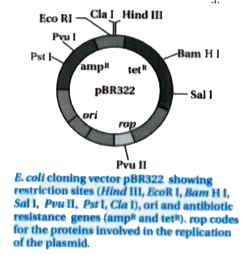Mention the features that are required to facilitate cloning into a vector.
Text Solution
(i) Origin of replication : Origin of replication is a specific sequence from where replication starts.
When any piece of DNA is linked to this sequence can be made to replicate within the host cells.
This sequence is also responsible for controlling the copy number of the linked DNA.
So if one wants to recover many copies of the target DNA, it should be, cloned in a vector whose origin support high copy number.
(ii) Selectable marker : In vector, there is selectable marker in addition to origin of replication.
Which helps in identifying and eliminating non transformants and selectively permitting the growth of the transformants.
Normally, the genes encoding resistance to antibiotic such as ampicillin, chloramphenicol tetracycline or kanamycin etc. are considered useful selectable markers for E. coli.
(iii) Cloning sites : In order to link the alien DNA, the vector needs to have very few, preferably single recognition sites for the commonly used restriction enzymes.
Presence of more than one recognition sites within the vector will generate several fragments, which will complicate the gene cloning.
The ligation of alien DNA is carried out at a restriction site present in one of the two antibiotic resistance genes.
For example, you can ligate a foreign DNA at the BamH I site of tetracycline resistance gene in the vector pBR322.
The recombinant plasmids will lose tetracycline resistance due to insertion of foreign DNA but can still be selected out from non recombinant ones by plating the transformants on tetracycline containing medium.
The transformants growing on ampicillin containing medium are then transferred on a medium containing tetracycline.
The recombinants will grow in ampicillin containing medium but not on that containing tetracycline. But non recombinants will grow on the medium containing both the antibiotics.
In this case, one antibiotic resistance gene helps in selecting the transformants, wher as the other antibiotic resistance gene gets inactivated due to insertion of alien DNA and helps in selection of recombinants.
Selection of recombinants due to inactivation of antibiotics is a cumbersome procedure because it requires simultaneous plating on two plates having different antibiotics.
Therefore alternative selectable markers have been developed which differentiate recombinants from non recombinants on the basis of their ability to produce colour in the presence of a chromogenic substrate.
For e.g. a recombinant DNA is inserted within the coding sequence of an enzyme, β-galactosidase,. This results into inactivation of the gene for synthesis off this enzyme which is referred to as insertional inactivation.
The presence of a chromogenic substrate gives blue coloured colonies if the plasmid in the bacteria does not have an insert. Presence of insert results into insertional inactivation of the α-galactosidase gene and the colonies do not produce any colour, these are identified as recombinant colonies.
(iv) Vectors for cloning genes in plants and animals : Bacteria and Viruses can be used for transferring genes into plants and animals.
Agrobacterium fumifaciens, a pathogen of several dicot plants is able to deliver a piece of DNA transform normal plant cells into a tumor Nowadays it is transformed into cloning vector.
Which is not a pathogenic but it is still able to use the mechanisms to deliver genes of our interest into a variety of plants.
Similarly retroviruses in animals have the ability to transform normal cells into cancerous cells. Which is recently useful by transforming into desired genes and enter into animal cells.

|
Topper's Solved these Questions
- BIOTECHNOLOGY : PRINCIPLES AND PROCESSESBOOK - KUMAR PRAKASHANCHAPTER - BIOTECHNOLOGY : PRINCIPLES AND PROCESSESEXERCISE - SECTION - B (DIFFERENCE/SCIENTIFIC REASONS)
5 Videos
- BIOTECHNOLOGY : PRINCIPLES AND PROCESSESBOOK - KUMAR PRAKASHANCHAPTER - BIOTECHNOLOGY : PRINCIPLES AND PROCESSESEXERCISE - SECTION - C (OBJECTIVE QUESTIONS - ANSWERS)
6 Videos
- BIODIVERSITY AND CONSERVATIONBOOK - KUMAR PRAKASHANCHAPTER - BIODIVERSITY AND CONSERVATIONEXERCISE - SECTION - F (MCQs A SKED IN COMPETITIVE EXAM)
70 Videos
- BIOTECHNOLOGY AND ITS APPLICATIONSBOOK - KUMAR PRAKASHANCHAPTER - BIOTECHNOLOGY AND ITS APPLICATIONSEXERCISE - Section - F (Multiple Choice Questions (MCQs ASKED IN COMPETITIVE EXAM))
90 Videos
Similar Questions
Knowledge Check
Which of the following features are required to facilitate cloning into a vector ?
a. Origin of replication (ori) b. Selectable marker c. Cloning siteAa and bBb and cCa and cDa, b and cAll of the following arc features required to facilitate cloning into a vector except:
ANutrient mediumBCloning sitesCSelectable markerDOrigin of replicationWhich of the following are required to facilitate cloning into a vector?
Aorigin of replicationBSelectable markerCCloning sitesDAll of these
Name any two cloning vectors. Describe the features required to facilitate cloning into a vector.
View SolutionA vector is engineered with three features to facilitate its cloning within the host cells. List three features.
View SolutionA vector is engineered with three features which facilitate its cloning within the host cell. List the three features and explain each one of them.
View SolutionCloning Vectors
View SolutionWhich is a cloning vector
View Solution
